
Finally going to tackle a topic I've been wanting to talk about for ages—Barrier Repair for your skin. A subject that is desperately needed with today's constant marketing of actives and acids, new launches as well as TikTok videos. Barrier Repair many times is caused by overdoing actives. Some of us with more sensitive skin like rosacea, eczema and dry skin will have barrier issues to begin with, even without overuse of actives. Seasonal changes can also play a big part. Barrier repair as a topic has grown during the pandemic due to the increase in popularity of skincare and TikTok. First thing you do when you get excited about skincare is go all in and maybe use a little too many actives. However, we've all been there. Who hasn't overdone it? You could be a skin expert and still overdo it on occasion and be in need of barrier repair. So let's start with what is your skin barrier?
Your skin is your largest organ. It's also really good at keeping things out (and in). The outermost layer of your skin is the stratum corneum. This top layer of the epidermis is a great protective barrier while also sealing everything inside like necessary moisture. I'll use the most common analogy for the epidermis which is the brick and mortar one. The cells are the bricks (corneocytes) while the mortar is the intracellular matrix (lipids). Together these form an impermeable barrier to the environment keeping things like pollutants, allergens and microorganisms out. There's even some talk of including your skin's own microbiota as a third component to its own barrier hence why your skins microbiome has become a bigger topic. Also remember that the bottom corneocytes naturally move towards the top as the skin renews itself and the cells mature. Now we can get a pile of these mature cells (don't call them dead they're not) on the surface causing dullness which is why everyone loves acids, peels and exfoliants among other things. Removing that top extra layers gives you a nice shiny new surface. Everyone loves a shiny new surface.
Problem is sometimes we can get carried away with our over-exposing of that surface through over use of active products in particular acids. Those who have genetic predispositions to barrier issues anyway (rosacea, dry skin, psoriasis and eczema) or live in a dry climate may also be at risk without any actives. You have to find the right balance between removing those outer mature corneocytes to get that glowing skin but also retain the natural defensive barrier. Sounds easy right? Not necessarily. The skincare world has constant acid launches by brands, bigger and stronger percentages of actives getting pushed, TikTok showing you the next fad that may destroy your skin's natural defenses plus our own thoughts of 'I can just push myself a little more I'm almost there'—If anyone tells you they've never destroyed their skin barrier at some point then they're just lying. Everyone has done it. I remember my young enthusiastic skincare beginner phase of acid toners in the morning with vitamin C and 20% acid serums at night with retinoids. I cringe now just thinking about it.
When you thin or remove that natural barrier too much you allow moisture to escape and tiny invisible cracks to form from barrier damage. You've compromised your skin barrier. You might notice dry, tight, more sensitive skin. Your skin might be red, flaky, peeling or itchy. You might notice stinging or burning from something as simple as a benign hyaluronic acid serum or moisturizer. You may notice more pronounced lines and texture or get exacerbations of eczema or breakouts. It's not just acids, physical exfoliants, other actives like vitamin C, devices that remove the excess layer and retinoids (especially prescription retinol) is also to blame. Too many actives can be irritating on the skin, keep your barrier from recovering naturally and being it's best. Anything that may dry your skin out, irritate it or remove that extra layer all have an effect. Even hot water from a shower, air conditioning and artificial heat all have a drying effect on the skin. Dry climates plus seasonal changes especially a drop in humidity all can wreak havoc on the skin. When you think about it your skin is fighting off several forms of attack daily. Sometimes it's just not a match for what we did to it.
So how do we fix it? First and foremost listen to your skin. Then stop the aggressors you can. You can't control the AC or heat but you can reduce water temperature in your shower and stop using actives. Two to four weeks is the average healing time but some may get away with one week, depends on your skin and how bad it is. Now if you don't heal with no actives and a simple replenishing routine after four weeks I would see a professional. Skip synthetic fragrance or essential oil products (potential irritation while you're trying to heal) plus products with drying alcohols (drying, potential irritation). Some people will be able to get back into the favorite alcohol containing SPF or product once they're healed, some may find this is a new trigger for them. If you find you go through barrier problems and keep adding that same active or type of product back in and it keeps happening then you may need to consider skipping that in the future. I always suggest adding one active at a time back into your routine, don't go all in again after you just spent a week healing.
Take the time to listen to your skin and pay attention to what it tells you. This is how I figured out what my triggers were. I can still use things like fragrance and essential oils but I do avoid them when I start feeling the beginning of my barrier being disrupted. I also had to cut out drying alcohol permanently. I used to use and it was fine, but now every time I use something with a good amount of alcohol (not the fatty ones) by day three I start to turn into a red, dry, irritated mess. One time use for me is fine, it's the consecutive uses that get me. That's how much I played around to see what my triggers were. I also noticed my rosacea gets a little worse with age, maybe also related to natural drying out from aging plus hormonal changes for me. It's going to be different for everyone. Some will have lots of issues and some it might just be a simple case of I over-exfoliated, I fixed it and I'm great and moved on. If you notice you have lots of issues and keep getting in barrier repair jail I would see a pro.
So you're going to start with using a gentle cleanser. I prefer an oil based one at night to help keep my skin from drying out, which helps a lot. I like one that can emulsify so I don't need a washcloth (can act as physical exfoliation) and no added fragrance or essential oils. Deviant Cleansing Concentrate has been one of my all time favorites for this. They’re not always accessible and are pricey. Plus recently they have some brand issues so I’m listing some other choices. The Inkey List Oat Cleansing Balm, Paula's Choice Omega + Complex Cleansing Balm are easier to find and cheaper. They're both great. In the morning I'll reach for a gel oil balm texture like Jordan Samuel Skin The After Show Treatment Cleanser for Sensitive Skin, The Ordinary Squalane Cleanser or just use water or a hydrating toner, you don't necessarily need a morning cleanser (if you use heavy balms or creams you might). I also love a gentle low pH gel cleanser that's not drying. Skin's natural pH is around 4.7-5.5 or so. Your skin's natural microflora is best in a slightly acidic environment. You've probably heard of acid mantle by now which is basically the skin's naturally acidic outer film on the stratum corneum. It's a natural barrier as well. So best bet is to use a lower pH cleanser not only during this time but in general to prevent barrier disruption. I prefer a cleanser around a pH of 5.5 but formulation matters as well. If you like luxury Augustinus Bader The Cream Cleansing Gel is fantastic, low pH, creamy and non-drying. Krave Beauty Matcha Hemp Cleanser, Acaderma Serenity Calming Cleanser, MAKE Beauty Succulent Skin Wash, Stratia Velvet Cleansing Milk, HoliFrog Superior Omega Gel Wash and Senté Daily Soothing Cleanser are all good choices.
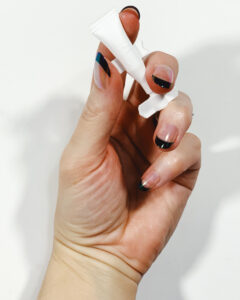
After cleansing the rest is all going to be geared towards soothing, hydrating and replenishing products. Think ceramides, fatty acids, cholesterol, hyaluronic acid and glycerin plus natural moisturizing factors like amino acids, sodium PCA, minerals, natural sugars, glucosamine, creatine, glycosaminoglycans (complex polysaccharides), urea and even lactic acid (small concentrations). I reach for soothing, hydrating, replenishing and skin repairing products to help restore my barrier. A key part for me is a light layer or two under the more heavy lipid layers. I have found a light layer or two that really absorbs well into the skin is helpful. I tend to skip the hyaluronic acid serums and look more for the restoring and replenishing types. Bioderma Matricium is a thin water light fluid that is intended for use on skin that is inflamed or irritated. It's made of things found naturally in the skin that are essential to cell life, regeneration and function essentially helping replenish and restore. It's great post procedure or in the winter just to help. It's a huge game changer for me and has become a staple just to help prevent issues. Sadly it's not available in the US so you have to order it from Europe, I get mine from caretobeauty (on sale I stock up) but there are other French retailers who sell as well like frenchcosmeticsforless and cocooncenter. Review HERE.
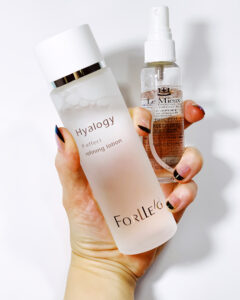
Essences make great hydrating layers. They're less thick and tend to hydrate better for me than some serums. Some of my favorites are Forlle'd Hyalogy P-Effect Refining Lotion and Acaderma Equilibria Stabilizing Toner. Both are fragrance free, light, slippery, hydrating and soothing. You can read more about both HERE. Le Mieux ISO-Cell Recovery Solution is probably the best mist I've ever used for barrier repair. It's fragrance free and has things like amino acids and minerals are also soothing, hydrating and restorative for the skin. It's also really affordable and a gem in the skincare world. Now if I'm just trying to prevent barrier issues around seasonal changes or have a mild barrier issue I'll use growth factors and copper tri-peptides. If I have major issues I'll skip them and just focus on healing but then I might add these in after a few days/week. I find growth factors in serums like AnteAGE GF|Serum or SkinMedica TNS Advanced+ Serum to be reparative and healing. It's a way to get that active like glow without the irritating active. Both are fragrance free. Read more about AnteAGE HERE. Le Mieux has some other options as well as Neocutis. NIOD CAIS or CAIL will always be my number one copper tri-peptide product. Copper tri-peptides have some wound healing properties and I find they can be really soothing at times. Not necessary but if you're looking for an active free month and want something to help your skin copper tri-peptides are nice. Read more about CAIS HERE.

Serums that are hydrating and contain NMF and ceramides are a great addition. Not necessary if you got an essence in there but I'm dry so I like both. Very much personal preference. Medik8 Hydr8 B5 Intense and Kate Somerville DeliKate Recovery Serum (formerly Ceramides + Omegas Serum) tend to be my go to as they're not overtly sticky and they are more than just a typical hydrating or hyaluronic acid serum. Medik8 has multiweight hyaluronic acid, natural moisturizing factors, panthenol, saskatoon berry and other interesting ingredients that help with moisture. Kate Somerville has a peptide complex, ceramides, cholesterol, fatty acids, hydrators, ginger root and tasmanian pepper. It has a light creamy serum texture that's not sticky or heavy. It's great for added needs and layering. Some of my other favorites are NIOD MMHC, Twelve Ideal Moisture Level Serum, YOU Skincare Essential Hydration Serum and Glow Recipe Avocado Ceramide Recovery Serum.
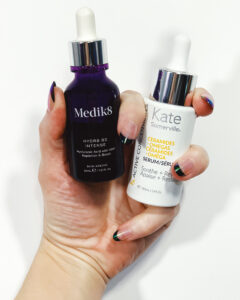
Soothing and lipid replenishing products are great. NIOD Modulating Glucosides is an emulsion that helps replenish and soothe. It has a lipid complex, bio-active glucosides, plus other complicated NIOD description ingredients (if you know you know). Think really soothing plus it has a nice hydrating creamy texture. There's just something about it. Stratia Liquid Gold is a cult classic. It replenishes the skin with ceramides and fatty acids plus cholesterol. All necessary to skin health and part of your skin barrier. This is a lotion textured product but it's pretty lipid rich. For me I can use it as either a day moisturizer or as a hydrating layer under a balm or heavier cream. Some with oily skin may feel this is too much, if you're drier you'll love it. It's pure and simple lipid replenishment. These two tend to be my go tos for that creamy layer beyond that I use a facial oil. Now I did forget to mention gel creams are fantastic layers as well. The only one I typically tend to use when in a crisis is Perricone Hyaluronic Intensive Moisturizer or Biologique Recherche Emulsion Gel Biosensible. These are great to layer as well for a more intensive long lasting hydrating layer.
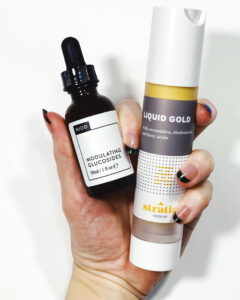
Facial oils to replenish essential fatty acids and nourish are vital. I love VOTARY Super Seed Facial Oil which is light in texture and essential oil free. It's easily one of the best light oils that replenishing and great for sensitized moments. More HERE. If you're not severely compromised Naturallogic Rarefy is a great soothing facial oil with blue tansy. I know I said no added fragrance or essential oils but blue tansy in particular is so healing for me. If you're more just preventing future problems in your barrier for a seasonal change or at the end of recovery you can consider it. This is my favorite blue tansy containing facial oil. It's not too heavy with that oil, very balanced and soothing. Plus it's a huge bottle an decently priced with a great texture. Any kind of facial oil without essential oils is great for barrier repair, they're especially great after a mist like Le Mieux. It really helps the oil absorb better.
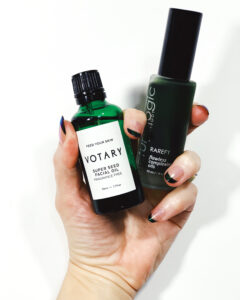
A good heavyish, occlusive, lipid rich cream is a must. Now my number one, all time favorite barrier repair cream of choice is Biologique Recherche Creme Masque Vernix which forms the most divine waxy coating on my skin. Sounds weird but it's so protective and really seals everything in. Keeps TEWL (transepidermal water loss) at a minimum which is important in recovery. A decent cheaper solution is La Roche Posay Cicaplast Baume. It's more greasy for me and not as long lasting nor as occlusive but it's a good one. Don't confuse a creams weight with how long lasting it is. Also look for ones that are more lipid heavy if you're drier. They'll last longer and feel better in the morning. They are heavy creams but they're just more butter or cream texture heavy but they can leave my face dry in the morning. You're looking for lipid rich creams here. Ultimately whicher occlusive layer works for you is best, if you're really oily yes you might pick less lipid heavy, if you're dry pick lipid rich as they last longer. Now The Ordinary Natural Moisturizing Factors + HA is a great lighter cream perfect for sensitized skin to replenish. Better for more combo to oily skin, if you're dry it's not enough as a night cream but a good day cream. You could use this before a balm or Vaseline for drier skin.
Vaseline is also an all time star in this type of situation. It's the most occlusive layer you'll get. If you're in a true barrier repair crisis this will be your savior. Apply a thin layer, not a thick paste. Never use Vaseline over actives, but over anything I've listed above it should be just fine. I've even spot used Vaseline on my cheekbones during a crisis it's oddly so soothing. It sucks for your pillowcase, but it works. If you have dry skin, rosacea, eczema or some kind of sensitive skin that has frequent issues in the winter or more then try Vaseline. I've even put Vaseline over a heavy cream and all those other serum layers and it still barely saved me. Dry skin is crisis a whole other animal.
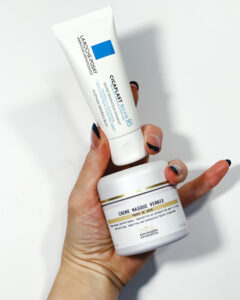
I love a good lipid heavy face balm. I've been known to use a balm and a heavy cream during crisis times (and yes I've even used Vaseline as well). Now you can have balms with no essential oils great for soothing and replenishing like Live Botanical Barrier Balm or you can pick a soothing blue tansy balm like May Lindstrom Blue Cocoon. Again it's not an essential oil free pick but it can really be so soothing. Live Botanical has this really nice lipid profile with a lighter whipped balm texture. It's very replenishing and nourishing. Blue Cocoon is more the soothing experience style balm. If you more barrier compromised I would pick Live Botanical to avoid essential oils. If you're more trying to prevent an issue from a weather change or something then Blue Cocoon might be just fine. You're going to have to listen to your skin and play around. Now have I used a balm and a facial oil? Yes. So I might use VOTARY Super Seed before Blue Cocoon or use Rarefy before Live Botanical. I don't use two blue tansy based products. And you don't need to but sometimes my skin just eats up both and remember I'm dry. And I don't break out from it. Unless you have that kind of skin you can't judge either. That's a whole other topic one day.
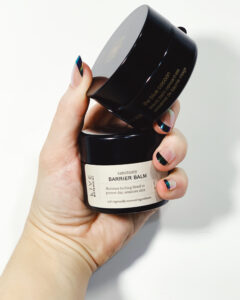
Sunscreen is also really important in the day to help protect against irritation from the sun. Many may pick mineral sunscreen but I tend to find it too drying so I use chemical. This may not be for everyone but it's what works for me. I reach for more advanced chemical filters than the US approved ones. I find them less irritating on the skin. Minerals can dry me out horribly and make the situation worse for me. This is a recent revelation for me and I would say do what works for you. I absolutely adore EVY Daily UV Face Mousse. It's a bitch to find in the US I get it and I will post soon about the whole line. It has a dewy finish and the chemicals never irritate my skin. Plus it lasts six hours without drying. Lately I also love ISDIN Fusion Water Pediatrics. Both are chemical and fragrance free, non-irritating filters. Some of my other favorites are Heliocare Water Gel and Isntree Hyaluronic Acid Watery Sun Gel. All of these are fantastic chemical choices. Heliocare Pigment Solution Fluid is my favorite hybrid (mineral and chemical) while Heliocare Mineral Tolerance Fluid is my favorite mineral fluid. It's not too drying. You can see my favorite mineral sunscreens HERE and it's not a big list. The chemical roundup is HERE.
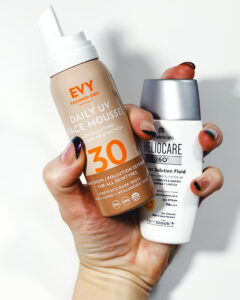
This was a lot of stuff to go over. It's also going to vary from person to person and skin type to skin type what works. I encourage you to play with what works for you. These are just things I've learned from my own trial and error as far as what works combined with general consensus on quitting actives and using repairing products. What repairing product and how long it takes will be very different person to person. It changes for me even season to season and event to event.
*Some items may have been PR

1 Comment